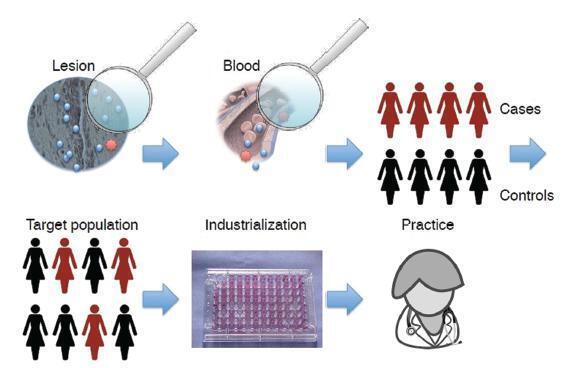-
Editorial
New Definition of Fetal Growth Restriction: Consensus Regarding a Major Obstetric Complication
Revista Brasileira de Ginecologia e Obstetrícia. 2017;39(7):315-316
07-01-2017
Summary
EditorialNew Definition of Fetal Growth Restriction: Consensus Regarding a Major Obstetric Complication
Revista Brasileira de Ginecologia e Obstetrícia. 2017;39(7):315-316
07-01-2017Views70Fetal growth restriction (FGR) affects 5–10% of all pregnancies, and it is the second leading cause of perinatal mortality, accounting for ∼ 30% of stillbirths; it leads to premature births and intrapartum asphyxia. Fetuses with FGR have an increased risk for perinatal morbidity and mortality, impaired neurological and cognitive development during childhood and adolescence, and […]See more -
Editorial
Progressive Resistance Training as Complementary Therapy for Polycystic Ovarian Syndrome
Revista Brasileira de Ginecologia e Obstetrícia. 2017;39(6):255-257
06-01-2017
Summary
EditorialProgressive Resistance Training as Complementary Therapy for Polycystic Ovarian Syndrome
Revista Brasileira de Ginecologia e Obstetrícia. 2017;39(6):255-257
06-01-2017Views74Polycystic ovarian syndrome (PCOS) significantly impacts women, since the broad spectrum of clinical manifestations associated with it are significant and include reproductive dysfunction, menstrual irregularities, and an increased risk of infertility. However, the consequences of PCOS go beyond the reproductive axis, with psychological and social impairments, including stress, depression, anxiety, and sexual dissatisfaction. There is […]See more -
Editorial
Patient Safety in Maternity Care in Brazil: The Maternity Safety Thermometer as a Tool to Improve the Quality of Care
Revista Brasileira de Ginecologia e Obstetrícia. 2017;39(5):199-201
05-01-2017
Summary
EditorialPatient Safety in Maternity Care in Brazil: The Maternity Safety Thermometer as a Tool to Improve the Quality of Care
Revista Brasileira de Ginecologia e Obstetrícia. 2017;39(5):199-201
05-01-2017Views96Over the last few years, the topic of maternity care in Brazil has been at the heart of several debates. One of the main reasons is the overuse of interventions such as high rates of caesarean section, augmentation of labor with uterotonics and amniotomy, uterine fundal pressure during the second stage of labor (Kristeller maneuver), […]See more -
Editorial
Future Perspectives for Uterine Cervical Cancer Treatment based on Integrative Genomic and Molecular Characterizations
Revista Brasileira de Ginecologia e Obstetrícia. 2017;39(4):147-148
04-01-2017
Summary
EditorialFuture Perspectives for Uterine Cervical Cancer Treatment based on Integrative Genomic and Molecular Characterizations
Revista Brasileira de Ginecologia e Obstetrícia. 2017;39(4):147-148
04-01-2017Views87Cervical cancer is the most frequent gynecologic malignancy in developing countries nowadays. Surgery is an effective treatment for the early stages of the disease. However, most patients are still diagnosed with inoperable locally advanced cervical cancer (LACC). In Brazil, the scenario is not different, and, according to Fundação Oncocentro de São Paulo (FOSP), from 2000 […]See more
-
Editorial
Biomarkers of Pelvic Endometriosis
Revista Brasileira de Ginecologia e Obstetrícia. 2017;39(3):91-93
03-01-2017
Summary
EditorialBiomarkers of Pelvic Endometriosis
Revista Brasileira de Ginecologia e Obstetrícia. 2017;39(3):91-93
03-01-2017Views106Endometriosis is typically a symptomatic disease, and the symptoms often manifest as dysmenorrhea, dyspareunia, chronic pelvic pain, and/or infertility. Deep infiltrating endometriosis can also produce cyclic urinary or intestinal complaints. Nevertheless, the symptoms of endometriosis are not specific, and may be associated with many other different conditions. Severe dysmenorrhea in adolescent girls may be underestimated […]See more
-
Editorial
Pregnancy in Adolescence – A Challenge Beyond Public Health Policies
Revista Brasileira de Ginecologia e Obstetrícia. 2017;39(2):41-43
02-01-2017
Summary
EditorialPregnancy in Adolescence – A Challenge Beyond Public Health Policies
Revista Brasileira de Ginecologia e Obstetrícia. 2017;39(2):41-43
02-01-2017Views117Recent Sustainable Development Goals were established by the United Nations (2015–2030), including the broad goal of “good health and wellbeing” for all. Good health and wellbeing (item 3), quality education (item 4), gender equality (item 5) and reduced inequalities (item 10) are among the 17 items of the list. These four cited goals are directly […]See more -
Editorial
Recurrent Urinary Tract Infection in the Gynecologic Practice: Time for Reviewing Concepts and Management
Revista Brasileira de Ginecologia e Obstetrícia. 2017;39(1):1-3
01-01-2017
Summary
EditorialRecurrent Urinary Tract Infection in the Gynecologic Practice: Time for Reviewing Concepts and Management
Revista Brasileira de Ginecologia e Obstetrícia. 2017;39(1):1-3
01-01-2017Views124Asymptomatic Bacteriuria Should Not Be Treated in the General Population Urinary tract infection is not a laboratory-defined diagnosis. Diagnosis should be based on clinical symptoms whenever possible, and confirmed by positive urine microscopy and culture. Quantitative colony counts should not be used to guide therapy in asymptomatic patients. In symptomatic women, colony counts of > […]See more -
Editorial
Zika Virus Outbreak and the Poor Brazilian Family Planning Program
Revista Brasileira de Ginecologia e Obstetrícia. 2016;38(12):583-584
12-01-2016
Summary
EditorialZika Virus Outbreak and the Poor Brazilian Family Planning Program
Revista Brasileira de Ginecologia e Obstetrícia. 2016;38(12):583-584
12-01-2016Views77The National Family Planning Policy was created in Brazil in 2007. It includes offering eight free contraceptive methods (intrauterine device [IUD] with copper, progestogen-only pill, combined pill, monthly injectable, depot medroxypro-gesterone, diaphragm, male and female condoms) and also some other oral and injectable contraceptives at reduced prices at “popular” pharmacies. In the last decades, modern […]See more


